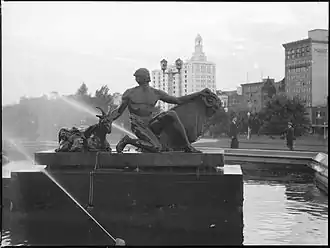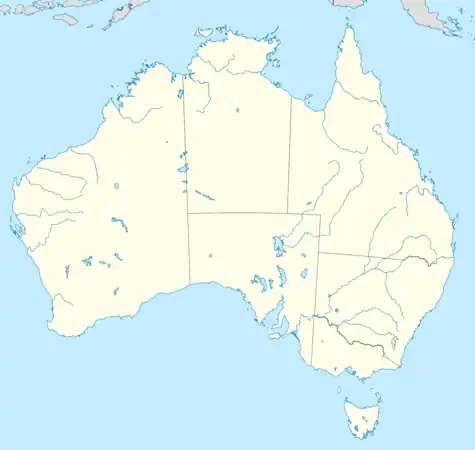Fontaine Archibald
La fontaine Archibald (en anglais Archibald Fountain), ou plus précisément la fontaine à la mémoire de J.F Archibald (J.F. Archibald Memorial Fountain), est une fontaine publique, se situant au sein de Hyde Park, dans le centre de Sydney (Nouvelle-Galles du Sud), en Australie.

| Artiste | |
|---|---|
| Date | |
| Type | |
| Localisation | |
| Coordonnées |
33° 52′ 16″ S, 151° 12′ 43″ E |
Elle doit son nom à J.F. Archibald, propriétaire et rédacteur en chef du magazine The Bulletin, qui laissa en legs les fonds nécessaires à sa construction. Archibald précisa que la fontaine devait être conçue par un artiste français, en raison de sa passion pour la culture française et aussi pour commémorer l'alliance de l'Australie avec la France durant la première Guerre mondiale. Il souhaitait que sa conception sur un thème civique et sa structure ornementale rivalisent avec celles des monuments de la ville de ses rêves, Paris. L'artiste choisi fut François-Léon Sicard.
La fontaine fut inaugurée le 14 mars 1932 par le maire de Sydney, Samuel Walder.
Texte anglais à traduire :
Classical tradition
Sicard was one of the foremost sculptors of his day, a classically educated artist, whose inspiration was derived, at least in part, from his study of classical Greek and Roman art and literature. In submitting his proposal for the design of the sculptural groups, Sicard wrote: "Apollo represents the Arts (Beauty and Light). Apollo holds out his right arm as a sign of protection, and spreads his benefits over all Nature, whilst he holds the Lyre in his left hand. Apollo is the warmth which vivifies, giving life to all Nature. At the touch of his rays, men awake, trees and fields become green, the animals go out into the fields, and men go to work at dawn.
"The ancient Pliny adored the sun, symbol of Life. It is on this account that I wished this figure to be the chief one in the memorial.
"At Apollo's feet the star of day is indicated by a semicircle, of which the rays spread out in jets of light (the rising sun). The horses' heads represent the horses of Apollo's chariot. Out of their nostrils the water will fall into the first basin, to fall from there into the second, and run away into the large basin.
"The large basin is divided into three groups. One represents Diana, goddess of purity, of peaceful nights, symbol of charity; the ideal which watches over mortals - all that stands for poetry and harmony. The second group symbolises the good things of the earth - it is the young god of the fields and pastures, of the pleasure of the countryside. The third group represents sacrifice for the public good. Theseus, vanquisher of the Minotaur. The spirit triumphs over bestiality. Theseus delivers his country from the ransom which it had to pay to this monster. It is the sacrifice of himself for the good of humanity. Between these groups tortoises throw jets of water. The fountain is electrically illuminated and floodlighted at night.
"It depicts Apollo, representing beauty and the arts, on a central column holding out his right arm as a sign of protection over all nature. On the three plinths radiating from the central column there are figures representing Diana, the goddess of purity; a group representing the good things of the earth; Theseus slaying a Minotaur, representing the sacrifice for the good of humanity."
Interestingly, Sicard quotes Pliny as one of the ancient Roman sources for the modern understanding of the qualities supposedly represented by the gods. Rather than merely using the visual examples of works such as those by Pheidias, the iconic sculptor of classical Athens, whose free standing and frieze statuary represent the acme of the classical depiction of the human form in larger-than life bronze or marble, Sicard used literary sources to explain the symbology behind the form. The figure with the ram and goat is possibly Aristaeus.
His choice of classical figures was in keeping with the European tradition of the sculpture and architecture of the precinct of Hyde Park. There is no indication in the writings of Sicard, or indeed, in the appraisal of his work, that there was any intention to link the figures in the sculptural groups with any religious or sexual themes.
Popular culture
Over the years the Archibald Fountain has been a chosen spot for photos, buskers, political rallies and just as a meeting place. Park benches are provided nearby, making it a popular location for city workers at lunchtime.
Préservation
En 2013, la fontaine fait l'objet de travaux d'entretien, comprenant le nettoyage minutieux de tous les éléments, et l'enduit à la cire des statues de bronze afin de préserver leur couleur et d'éviter la corrosion par l'air marin et la pollution, ainsi que le rejointoiement de la base de granit[1].
Masse critique
La fontaine Archibald de Hyde Park est le point de départ de la Masse critique de Sydney, une manifestation à bicyclette. La Masse critique de Sydney a lieu à partir de 17:30 chaque dernier vendredi du mois[2].
Galerie
 La fontaine Archibald, à Hyde Park, Sydney
La fontaine Archibald, à Hyde Park, Sydney La fontaine Archibald (détail)
La fontaine Archibald (détail) La fontaine Archibald avec la Sydney Tower en arrière-plan
La fontaine Archibald avec la Sydney Tower en arrière-plan
Liens externes
- (en) Référence et article (cc-by-sa) sur la fontaine Archibald dans le Dictionary of Sydney
- (en) The Archibald Fountain - City of Sydney Virtual Exhibition
- (en) Catalogue des monuments commémératifs de la première guerre mondiale de Nouvelle-Galles du Sud
- (en) Vidéo sur YouTube montrant la fontaine Archibald]
Références
- (en)Julian Bickersteth, « Museum Musings: Mr Archibald and his fountain », sur bickersteth.blogspot.com.au, (consulté le )
- « Critical Mass Sydney », sur bikesarefun.org (consulté le )

